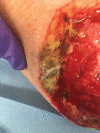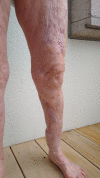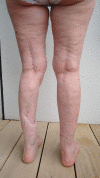Cutaneous Invasive Fungal Infections with Saksenaea Species in Immunocompetent Patients in Europe: A Systematic Review and Case Report
- PMID: 35415064
- PMCID: PMC8994077
- DOI: 10.1097/GOX.0000000000004230
Cutaneous Invasive Fungal Infections with Saksenaea Species in Immunocompetent Patients in Europe: A Systematic Review and Case Report
Abstract
Invasive fungal infections from Saksenaea, a fungus belonging to the Mucorales, have been rarely reported in central European climate zones. This study aims to raise awareness of invasive cutaneous infections with Saksenaea species. The first case of a cutaneous infection was diagnosed in Switzerland in an immunocompetent 79-year-old patient. A minor skin trauma of her left lower leg led to a fulminant infection causing necrosis and extensive loss of tissue. The combination of surgical debridement and administration of antifungal agents averted a prolonged course with a possible worse outcome. A pedicled hemisoleus muscle flap was used to reconstruct the defect and treatment was continued for 63 days.
Methods: A systematic review in accordance with the Preferred Reporting Items for Systematic review and Meta-Analysis guidelines was conducted to identify all European cases of infection with Saksenaea species in immunocompetent hosts. The epidemiology, clinical presentation, microbiological diagnosis, and management of cases reported in Europe were summarized and analyzed.
Conclusions: The prognosis of soft tissue infections with Saksenaea species. depends on early diagnosis and appropriate antifungal and surgical treatment. Reconstruction can be successful under ongoing antifungal treatment.
Copyright © 2022 The Authors. Published by Wolters Kluwer Health, Inc. on behalf of The American Society of Plastic Surgeons.
Figures








Similar articles
-
Saksenaea erythrospora, an emerging mucoralean fungus causing severe necrotizing skin and soft tissue infections - a study from a tertiary care hospital in north India.Infect Dis (Lond). 2017 Mar;49(3):170-177. doi: 10.1080/23744235.2016.1239027. Epub 2016 Oct 4. Infect Dis (Lond). 2017. PMID: 27701965
-
Saksenaea vasiformis infections: A case of an immunocompetent adult after mild injury and a literature review.J Mycol Med. 2019 Sep;29(3):260-264. doi: 10.1016/j.mycmed.2019.06.005. Epub 2019 Jul 25. J Mycol Med. 2019. PMID: 31445820 Review.
-
Fatal necrotising cutaneous mucormycosis due to novel Saksenaea species: a case study.J Wound Care. 2021 Jun 2;30(6):465-468. doi: 10.12968/jowc.2021.30.6.465. J Wound Care. 2021. PMID: 34121440
-
[Necrotising fasciitis caused by Saksenaea vasiformis in an immunocompetent patient after a car accident].Rev Iberoam Micol. 2013 Jan 3;30(1):57-60. doi: 10.1016/j.riam.2012.06.002. Epub 2012 Jun 29. Rev Iberoam Micol. 2013. PMID: 22749974 Spanish.
-
Cutaneous Mucormycosis by Saksenaea vasiformis: An Unusual Case Report and Review of Literature.Mycopathologia. 2019 Feb;184(1):159-167. doi: 10.1007/s11046-018-0249-6. Epub 2018 Jul 30. Mycopathologia. 2019. PMID: 30062390 Review.
Cited by
-
Epidemiological Trends of Mucormycosis in Europe, Comparison with Other Continents.Mycopathologia. 2024 Nov 20;189(6):100. doi: 10.1007/s11046-024-00907-5. Mycopathologia. 2024. PMID: 39565510 Review.
-
Alternative in-vivo models of mucormycosis.Front Cell Infect Microbiol. 2024 Feb 1;14:1343834. doi: 10.3389/fcimb.2024.1343834. eCollection 2024. Front Cell Infect Microbiol. 2024. PMID: 38362495 Free PMC article. Review.
References
-
- Bartram L, Aaron JG. Fungal necrotizing skin and soft tissue infections. Curr Fungal Infect Rep. 2019;13:146–156.
-
- Prabhu RM, Patel R. Mucormycosis and entomophthoramycosis: a review of the clinical manifestations, diagnosis and treatment. Clin Microbiol Infect. 2004;10 suppl 1:31–47. - PubMed
-
- Jeong W, Keighley C, Wolfe R, et al. . The epidemiology and clinical manifestations of mucormycosis: a systematic review and meta-analysis of case reports. Clin Microbiol Infect. 2019;25:26–34. - PubMed
LinkOut - more resources
Full Text Sources
